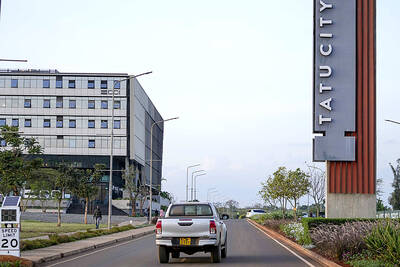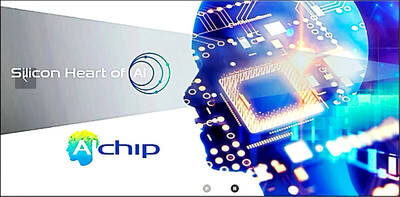There is a sensor in a bra, in a pair of socks, on a person’s wrist, attached to their chest and inside their ears — wearable tech is spreading all over the body.
The growing use of embedded wearable devices connected to a smartphone is spawning a massive industry geared to fitness, health and other goals, offering potential benefits to everyone from the newborn infant to the infirm elderly.
It was also one of the hottest sectors on display at this week’s Consumer Electronics Show (CES) in Las Vegas, Nevada, the largest annual showcase of tech-related gear.

Photo: AFP / Courtesy of Heapsylon
“Our vision is that the garment is the next computer,” Heapsylon LLC chief executive Davide Vigano said.
Heapsylon makes the Sensoria Fitness bra, T-shirt and socks, which connect to a smartphone designed for runners and others who want to monitor their health and improve workouts.
The company, which is participating in the show’s panels and displaying the products on the sidelines of the giant expo, said the items’ key features are “100 percent textile sensors” woven into fabric to be more comfortable and combine use of a transmitter on the socks with the chest monitor to more accurately track activity.
“We get a more accurate picture when the socks and bra work together,” Vigano said.
Like several new wearables coming on the market, Sensoria includes a “virtual coach” to help boost motivation and improve technique.
The fitness sector is one of the key areas in wearables, led by devices such as FitBit Inc’s eponymous activity tracker and Nike Inc’s +FuelBand. Smartwatches are another big segment, with offerings from the crowd-funded Pebble, giants such as Samsung Electronics Co and Qualcomm Inc, and others showing their wares in a new “wrist revolution” zone on the showroom floor, in addition to the large health and fitness section.
Several connected eyewear products are also being shown at the fair, even if Google Inc’s Glass is absent.
Juniper Research projects that the smart wearable-device market will reach US$19 billion by 2018 compared with US$1.4 billion last year, including segments such as fitness, health and security.
Intel Corp chief executive Brian Krzanich told the CES that the chipmaker is making a major push into wearable tech and showed off some of its products to be released this year, including a watch, earbuds which can monitor the wearer’s heart rate and a “onesie” for young infants that can allow parents to monitor a baby’s breathing, sleeping, temperature and positioning.
“We want to make everything smart. That’s what Intel does,” he said.
App makers are leveraging smartphone technology for medical purposes, such as monitoring blood pressure and glucose levels.
“The whole idea of allowing you to take control of your own health care is one of the great benefits of this technology,” Samsung vice president David Lowe told a show panel on Wednesday.
San Francisco-based Qardio Inc produces wearable heart and blood pressure monitors which allow people to keep an eye on their health on a smartphone or deliver the data to a doctor.
Qardio’s Rosario Iannella said the devices mean he can keep tabs on his elderly mother in Italy.
It also “allows doctors to give better care without spending more time with patients,” he said.
However, makers of wearable tech need to overcome the “geek factor,” or clumsy-looking devices which are unappealing, especially for women.
“The first products on the market are big and bulky and lend themselves to a male techno audience because it’s engineering-driven,” said Rob Enderle, a consultant and analyst with Enderle Group. “For women it will have to get smaller and more focused on fashion.”
ABI Research analyst Jeff Orr said that the first wave of gadgets may not be appealing, but “the second and third waves will be more important,” adding that any new devices must blend fashion with practicality.
Among some of the more fashionable items are being displayed at the Las Vegas trade show is the June bracelet from French startup Netatmo, which monitors sun exposure to help users avoid damaging ultraviolet rays, delivering data to a smartphone.
“This allows you to track exposure to the sun in real time, but it looks like a stylish gemstone bracelet,” Netatmo’s Emanuelle Thomas said. “It also acts as a personal coach, with recommendations based on your habits.”
British-based CSR PLC is introducing Bluetooth wireless-enabled smart jewelry that can create customized colors and brightness to suit a user’s mood and get alerts from a smartphone, while Hong Kong-based watchmaker Ezio is concentrating on style, while gradually adding apps and connectivity to its devices.
“Most of the smartwatches out there are very techy looking,” Ezio’s Terry Linebarge said. “We are focusing on the fashion watch, but with smart features.”

To many, Tatu City on the outskirts of Nairobi looks like a success. The first city entirely built by a private company to be operational in east Africa, with about 25,000 people living and working there, it accounts for about two-thirds of all foreign investment in Kenya. Its low-tax status has attracted more than 100 businesses including Heineken, coffee brand Dormans, and the biggest call-center and cold-chain transport firms in the region. However, to some local politicians, Tatu City has looked more like a target for extortion. A parade of governors have demanded land worth millions of dollars in exchange

An Indonesian animated movie is smashing regional box office records and could be set for wider success as it prepares to open beyond the Southeast Asian archipelago’s silver screens. Jumbo — a film based on the adventures of main character, Don, a large orphaned Indonesian boy facing bullying at school — last month became the highest-grossing Southeast Asian animated film, raking in more than US$8 million. Released at the end of March to coincide with the Eid holidays after the Islamic fasting month of Ramadan, the movie has hit 8 million ticket sales, the third-highest in Indonesian cinema history, Film

Taiwan Semiconductor Manufacturing Co’s (TSMC, 台積電) revenue jumped 48 percent last month, underscoring how electronics firms scrambled to acquire essential components before global tariffs took effect. The main chipmaker for Apple Inc and Nvidia Corp reported monthly sales of NT$349.6 billion (US$11.6 billion). That compares with the average analysts’ estimate for a 38 percent rise in second-quarter revenue. US President Donald Trump’s trade war is prompting economists to retool GDP forecasts worldwide, casting doubt over the outlook for everything from iPhone demand to computing and datacenter construction. However, TSMC — a barometer for global tech spending given its central role in the

Alchip Technologies Ltd (世芯), an application-specific integrated circuit (ASIC) designer specializing in server chips, expects revenue to decline this year due to sagging demand for 5-nanometer artificial intelligence (AI) chips from a North America-based major customer, a company executive said yesterday. That would be the first contraction in revenue for Alchip as it has been enjoying strong revenue growth over the past few years, benefiting from cloud-service providers’ moves to reduce dependence on Nvidia Corp’s expensive AI chips by building their own AI accelerator by outsourcing chip design. The 5-nanometer chip was supposed to be a new growth engine as the lifecycle